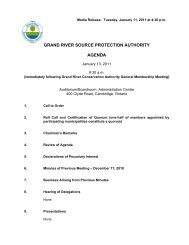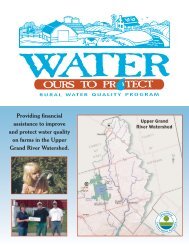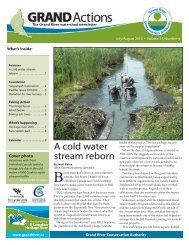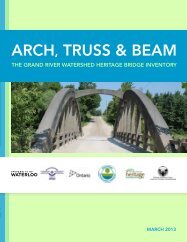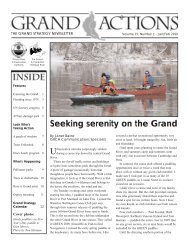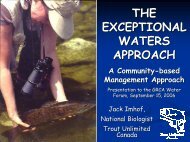Shand Dam a first for Canada - Grand River Conservation Authority
Shand Dam a first for Canada - Grand River Conservation Authority
Shand Dam a first for Canada - Grand River Conservation Authority
Create successful ePaper yourself
Turn your PDF publications into a flip-book with our unique Google optimized e-Paper software.
THE GRAND STRATEGY NEWSLETTER Volume 14, Number 2 - March/April 2009<br />
<strong>Grand</strong> <strong>River</strong><br />
<strong>Conservation</strong><br />
<strong>Authority</strong><br />
The <strong>Grand</strong>:<br />
A Canadian<br />
Heritage <strong>River</strong><br />
75th anniversary<br />
<strong>Shand</strong> <strong>Dam</strong> a <strong>first</strong><br />
<strong>for</strong> <strong>Canada</strong> 1<br />
No river needs two<br />
authorities 3<br />
GVTA hiking events 4<br />
Earth Day 5<br />
Features<br />
Bald eagles 6<br />
Frazil ice 7<br />
Watershed awards<br />
<strong>River</strong>’s Edge<br />
Goat Dairy 8<br />
April 30 deadline 9<br />
Milestones<br />
Rural focus <strong>for</strong><br />
heritage workshop 10<br />
Heritage inventory 11<br />
What’s happening?<br />
Scholarship available 11<br />
<strong>Grand</strong> Strategy<br />
Calendar 12<br />
Cover photo<br />
The July 11, 1939, sod<br />
turning ceremony <strong>for</strong><br />
construction of <strong>Shand</strong><br />
<strong>Dam</strong>, with Minister of<br />
Public Works Colin<br />
Campbell at the shovel.<br />
<strong>Shand</strong> <strong>Dam</strong> a <strong>first</strong> <strong>for</strong> <strong>Canada</strong><br />
By Janet Baine<br />
GRCA Communications Specialist<br />
Be<strong>for</strong>e the <strong>Shand</strong> <strong>Dam</strong> and the other major<br />
reservoirs on the <strong>Grand</strong> <strong>River</strong> opened, the<br />
river was sometimes a raging, uncontrolled torrent<br />
that menaced property owners all along its<br />
banks, and at other times it was a smelly trickle<br />
of sewer water.<br />
The <strong>first</strong> <strong>Grand</strong> <strong>River</strong> dam, the <strong>Shand</strong> <strong>Dam</strong>,<br />
started to change all that. It came about after<br />
years of struggle to find a reservoir plan, a political<br />
structure and funding. The <strong>first</strong> big step<br />
taken by the <strong>Grand</strong> <strong>River</strong> <strong>Conservation</strong><br />
Commission (<strong>for</strong>med in 1934) was to hire H. G.<br />
Acres & Co. of Niagara Falls during the summer<br />
of 1938 to come up with a reservoir plan and<br />
then supervise construction of the new dam.<br />
Soliciting government funds was another big<br />
problem that solved itself as the Great<br />
Depression lingered. Money flowed to the project<br />
thanks to the lean years<br />
and what today’s government<br />
would call<br />
infrastructure spending<br />
as part of an economic<br />
stimulus package.<br />
The federal and<br />
provincial governments<br />
each kicked in 37.5 per<br />
cent of the $2-million<br />
cost of the dam, while the eight local municipalities<br />
that made up the GRCC (Brant<strong>for</strong>d, Galt,<br />
Fergus, Elora, Paris, Kitchener, Waterloo and<br />
Preston) paid 25 per cent. In return, the municipalities<br />
got the dam and jobs <strong>for</strong> some of the<br />
unemployed people in their communities, helping<br />
to lighten their welfare rolls.<br />
Municipalities contributed different amounts<br />
based on a <strong>for</strong>mula that had been developed a<br />
few years earlier. The overall project cost included<br />
acquiring 2,000 acres of land. Half of<br />
Belwood, along with most of its businesses, were
affected by the construction.<br />
The project got underway in 1939. At<br />
the peak, an on-site construction camp<br />
included a dozen buildings to house 200<br />
men. Most of the unskilled labourers<br />
were from the towns and cities in the<br />
<strong>Grand</strong> <strong>River</strong> and they lived on the worksite.<br />
While machines were used, there<br />
was also lots of manual work.<br />
When WW II began in September<br />
1939, the provincial and federal governments<br />
decided the project was too far<br />
along to be put on hold <strong>for</strong> the war.<br />
Instead, once the<br />
high spring waters<br />
subsided in April<br />
1940, there was big<br />
push to complete<br />
the dam quickly.<br />
By Nov. 14,<br />
1940, all Canadian<br />
records were broken<br />
when 256,000<br />
William Philip<br />
cubic metres of clay<br />
had been put in place and compacted in<br />
just five weeks. The dam’s steel gates<br />
were installed and the dam was complete<br />
by the end of January 1942. The<br />
“last spike” on a railway that had to be<br />
moved due to the dam construction was<br />
driven in by <strong>Grand</strong> <strong>River</strong> <strong>Conservation</strong><br />
Commission chair William Philip on<br />
March 9, and then the <strong>first</strong> train crossed<br />
over the dam.<br />
Opened to great fanfare<br />
It opened with great fanfare on Aug.<br />
7, 1942, with 3,500 people on hand.<br />
There is still some film footage of the<br />
opening. A street dance<br />
and food <strong>for</strong> 5,000<br />
people were provided<br />
by Raynor<br />
Construction, the firm<br />
hired to build the dam. It<br />
was the largest party ever held in<br />
Fergus. The post office even issued a<br />
special cancellation stamp on mail from<br />
Elora and Fergus that day.<br />
At <strong>first</strong>, the new dam was called the<br />
<strong>Grand</strong> Valley <strong>Dam</strong>, but tourists searching<br />
<strong>for</strong> it ended up at <strong>Grand</strong> Valley, 18<br />
km upstream. As a result, it was<br />
renamed the <strong>Shand</strong> <strong>Dam</strong> after a local<br />
pioneer family.<br />
The <strong>Shand</strong> <strong>Dam</strong> garnered national<br />
and international attention. The<br />
Financial Post ran a front page story a<br />
year after the dam opened, with a headline<br />
that proclaimed “<strong>Grand</strong> Valley masters<br />
its river.” The article began: “Postwar<br />
projects that will pay <strong>for</strong> themselves,<br />
prevent serious annual losses and<br />
permanent injury to otherwise productive<br />
land offer attractions impossible to<br />
ignore.” It described the value of large<br />
engineering projects that would also provide<br />
post-war jobs <strong>for</strong> returning soldiers.<br />
The <strong>Shand</strong> <strong>Dam</strong> was the <strong>first</strong> largescale<br />
multi-purpose dam in <strong>Canada</strong>, and<br />
it <strong>for</strong>med a 12-km long lake — water<br />
that is held back to prevent flooding and<br />
then let out during the dry summer<br />
months to supply fresh water to communities<br />
downstream.<br />
<strong>Dam</strong>age costs averted<br />
That value was proven after<br />
Hurricane Hazel in 1954. The Toronto<br />
area suffered tremendous loss of life and<br />
property, but no one died in the <strong>Grand</strong><br />
<strong>River</strong> watershed as a result of the hurricane.<br />
The Toronto Star gave high praise<br />
to the <strong>Shand</strong> <strong>Dam</strong> <strong>for</strong> protecting people<br />
and property in a lead editorial with the<br />
headline “Big <strong>Dam</strong> Saved Cities.”<br />
The reservoir system in the <strong>Grand</strong><br />
<strong>River</strong> watershed has made the lives of<br />
watershed residents much less susceptible<br />
to the problems of flooding. They<br />
have paid <strong>for</strong> themselves many times<br />
over. They reduced flood damage significantly<br />
twice this winter — once in the<br />
thaw in late December and a second<br />
time in mid-February.<br />
Today we know that large engineering<br />
projects such as this minimize the<br />
impact of flooding and drought, but<br />
don’t eliminate these problems. Instead,<br />
dams are one of several measures that<br />
help to keep people and property safe<br />
from flooding by counterbalancing the<br />
impact of climate change and development<br />
that removes water storage from<br />
the land.<br />
Photos from top: sod turning ceremony<br />
<strong>for</strong> the <strong>Shand</strong> <strong>Dam</strong>; construction in<br />
October 1940; a visit to the worksite;<br />
logs on GRCC truck; mayors from the<br />
three communities that benefited from<br />
the dam were William Pelz of Preston,<br />
Joe Meinzinger of Kitchener and J. P.<br />
Ryan of Brant<strong>for</strong>d.<br />
2<br />
Share the resources - Share the responsibility
‘No river needs two authorities’<br />
Commissioner Hugh Templin<br />
By Janet Baine<br />
GRCA Communications Specialist<br />
Through a quirk of history, two<br />
organizations sprung up at different<br />
times to manage the unpredictable<br />
<strong>Grand</strong> <strong>River</strong>, which could be tame and<br />
docile or wild and wicked.<br />
Both were partnerships of municipalities<br />
and they were legislated by provincial<br />
acts that outlined their role and gave<br />
them similar mandates.<br />
The <strong>Grand</strong> <strong>River</strong> <strong>Conservation</strong><br />
Commission (GRCC) was the <strong>first</strong> and it<br />
was <strong>for</strong>med in 1934. The commission<br />
got to work building dams and planting<br />
trees on conservation lands. It was a<br />
bold and innovative organization <strong>for</strong> its<br />
time — a true leader in the conservation<br />
movement. The commission built three<br />
dams starting with the <strong>Shand</strong> <strong>Dam</strong>,<br />
<strong>Canada</strong>’s <strong>first</strong> large multi-purpose dam<br />
in 1942.<br />
Concern about environmental degradation<br />
in the province led to the Guelph<br />
Conference on <strong>Conservation</strong> in 1941,<br />
where dire predictions about the future<br />
were made:<br />
“All renewable natural resources of<br />
the province are in an unhealthy state.<br />
None of these natural resources will<br />
restore themselves under present conditions<br />
and the need <strong>for</strong> far-reaching measures<br />
of restoration and conservation is<br />
acute. Without them, conditions will get<br />
progressively worse.”<br />
This conference helped pave the way<br />
<strong>for</strong> the <strong>Conservation</strong> Authorities Act of<br />
Ontario, which led to a network of conservation<br />
authorities modelled in part on<br />
the GRCC. The legislation was delayed<br />
until after WW II and was passed in<br />
1946. This system of local watershed<br />
management agencies that protect and<br />
manage water and other natural<br />
resources remains unique in <strong>Canada</strong>.<br />
The <strong>first</strong> conservation authorities<br />
The GRCC at the Brant<strong>for</strong>d Golf andCountry Club <strong>for</strong> the 45th anniversary May 30,<br />
1979. Standing (left to right) Richard Beckett, Brant<strong>for</strong>d; Vernon Bauman, Waterloo;<br />
Reg Cooper, Brant<strong>for</strong>d; Ilmar Kao (secretary-treasurer) Cambridge; Mel Sharp,<br />
Paris; Lloyd Hogarth, Brant<strong>for</strong>d; Robert Pequegnat, Kitchener. Seated, P.A.<br />
Ballachey, Brant<strong>for</strong>d; Norman Drimmie, Elora; Marcel Pequegnat, Kitchener; Jim<br />
Bauer, Waterloo; Bruce Weber, Kitchener.<br />
<strong>Dam</strong>s on the <strong>Grand</strong><br />
The GRCA operates 32 dams, including<br />
eight major dams that were constructed<br />
by the GRCA or the GRCC.<br />
Their storage capacity is listed in<br />
cubic metres:<br />
1942-<strong>Shand</strong> <strong>Dam</strong>, 63.9 million<br />
1952-Luther dam, 28 million<br />
1958- Conestogo <strong>Dam</strong>, 59.5 million<br />
1968- Laurel <strong>Dam</strong>, 2.4 million<br />
1973- Shade’s Mills <strong>Dam</strong>, 3.2 million<br />
1974-Woolwich <strong>Dam</strong>, 5.5 million<br />
1976- Guelph Lake <strong>Dam</strong>, 22.4 million<br />
1978- <strong>Dam</strong>ascus <strong>Dam</strong>, 1.5 million<br />
under the new act were Etobicoke,<br />
Ausable and Ganaraska. The <strong>Grand</strong><br />
Valley <strong>Conservation</strong> <strong>Authority</strong> (GVCA)<br />
was the 10th in the province.<br />
At the <strong>first</strong> meeting about <strong>for</strong>ming it,<br />
GRCC Chair William Philip spoke about<br />
the need <strong>for</strong> a development master plan<br />
<strong>for</strong> the <strong>Grand</strong> <strong>River</strong> watershed that the<br />
authority could undertake. At that time,<br />
the conservationists saw a division of<br />
responsibility — the commission would<br />
focus on building dams and infrastructure<br />
as well as planting trees, while the<br />
authority’s role was to develop a master<br />
plan and acquire sensitive lands.<br />
Ontario’s <strong>first</strong> Planning and<br />
Development Minister, Dana Porter, had<br />
reservations about having two conservation<br />
organizations within one watershed.<br />
Porter agreed, expecting they would<br />
merge.<br />
The commission had eight municipal<br />
members, while the authority covered a<br />
bigger area and had 71 municipal members<br />
at the beginning.<br />
In the 1950s the GRCC focused on<br />
building Luther <strong>Dam</strong>, Conestogo <strong>Dam</strong><br />
and planting five million trees on its<br />
three dam sites. The GVCA acquired<br />
wetlands, <strong>for</strong>ests and natural areas, as<br />
well as parkland. Many of today’s popular<br />
conservation areas, including Elora<br />
GRAND ACTIONS • March/April 2009 3
Gorge, Rockwood, Pinehurst Lake and<br />
Byng Island, were purchased and developed<br />
by the authority.<br />
When the GVCA began to look into<br />
constructing a reservoir northeast of<br />
Guelph, it was stepping into the GRCC’s<br />
territory. The objectives of the two<br />
organizations were becoming parallel.<br />
A wedding or hostile takeover?<br />
In 1964 the new Minister of Energy<br />
and Resources, J. R. Simonett, called<br />
representatives of the eight municipalities<br />
that <strong>for</strong>med the commission to<br />
Toronto and told them the commission<br />
would have saved<br />
$500,000 over the<br />
years if it had<br />
amalgamated with<br />
the <strong>Grand</strong> Valley<br />
<strong>Conservation</strong><br />
<strong>Authority</strong>.<br />
Interestingly, he<br />
didn’t invite the<br />
commission members<br />
themselves to<br />
Jim Bauer the meeting.<br />
“It might not be fair to say the minister<br />
delivered an ultimatum, but he politely<br />
but firmly stated the commission had<br />
to become amalgamated with the authority,<br />
which at present looks after the<br />
recreation along the valley and does all<br />
the other things except build and manage<br />
dams and other things,” wrote Hugh<br />
Templin, who attended the meeting and<br />
conceded that while he was sad about<br />
the turn of events, no river needs two<br />
authorities.<br />
Amalgamation seemed inevitable, and<br />
the commission soon unanimously<br />
agreed to invite the chief executives of<br />
the GVCA to all future general meetings.<br />
The <strong>first</strong> joint meeting was in<br />
October 1966, but a transition period<br />
followed and it wasn’t until Dec. 31,<br />
1968, that the two organizations merged<br />
and got a new name — the <strong>Grand</strong> <strong>River</strong><br />
<strong>Conservation</strong> <strong>Authority</strong>. Jim Bauer, a<br />
<strong>for</strong>mer mayor of the City of Waterloo,<br />
was appointed by the province as the<br />
chair, since he had been on both the<br />
GRCC and the GVCA and was accepted<br />
by both.<br />
When they joined together, it was<br />
variously described as a wedding and a<br />
hostile takeover, a swallowing up of the<br />
commission by the authority.<br />
Undoubtedly there were some hard feelings,<br />
but it was also a natural and necessary<br />
step.<br />
Today the GRCA manages the<br />
biggest watershed in southern Ontario,<br />
bigger even than the province of Prince<br />
Edward Island. It operates the most<br />
complex water management infrastructure.<br />
It has the most municipal partners<br />
— 34-lower tier and four upper-tier. The<br />
complexity of the watershed presents<br />
many challenges to the 26 board members,<br />
who need to work together in order<br />
to improve the natural resources.<br />
ANNIVERSARY<br />
EVENT<br />
GVTA marks 75th<br />
with many hikes<br />
If you enjoy hiking or think you’d like<br />
to give it a try, get your hiking boots<br />
ready <strong>for</strong> lots of opportunities to hike the<br />
<strong>Grand</strong> Valley Trail this year.<br />
In honour of the 75th anniversary of<br />
the GRCA, the <strong>Grand</strong> Valley Trail<br />
Association has planned three different<br />
series of hikes that will keep people on<br />
their feet from April to December.<br />
The GVTA has 400 members from<br />
across the watershed. Since 1972, they<br />
have been working with landowners to<br />
create the 275-km <strong>Grand</strong> Valley Trail.<br />
This runs along the <strong>Grand</strong> <strong>River</strong> from its<br />
mouth at Lake Erie up through<br />
Brant<strong>for</strong>d, Waterloo, and Fergus all the<br />
way to Alton, near Orangeville.<br />
The GVTA is holding these hikes as<br />
part of the 75th anniversary celebrations<br />
of the GRCA because the two organizations<br />
work closely together, said Georgia<br />
Mulholland, the GVTA president.<br />
“There is a lot of interaction between<br />
our two organizations and we’d like to<br />
foster that relationship,” she said. “It’s<br />
also a new opportunity to introduce people<br />
to the <strong>Grand</strong> Valley Trail.”<br />
‘Best of the <strong>Grand</strong>’ hikes<br />
The “Best of the <strong>Grand</strong>” hikes are<br />
open to the public. They will be two or<br />
three hours and will explore different<br />
spots along the <strong>Grand</strong> Valley Trail. The<br />
<strong>first</strong> of these is Saturday April 18, and<br />
hikers should meet be<strong>for</strong>e 10 a.m. in the<br />
parking lot of the Elora and District<br />
Community Centre, 60 David Street,<br />
Elora. This is a 15-km loop, but hikers<br />
will be able to drop out in Fergus. The<br />
other three hikes in the series will be at<br />
Snyder’s Flats, Brant<strong>for</strong>d to Paris and<br />
Ruthven Park National Historic Site.<br />
Details will be posted as they are finalized.<br />
Family hikes<br />
Family hikes will be loops that start<br />
and end at the same point and are no<br />
more than two hours. These are <strong>for</strong> children<br />
accompanied by adults and will be<br />
GVTA president Georgia Mulholland<br />
will lead the end-to-end hike this summer.<br />
Here she helps with trail maintenance.<br />
4<br />
Share the resources - Share the responsibility
at a leisurely pace on well defined trails<br />
with gentle inclines, suitable <strong>for</strong> new<br />
hikers and families. They will be at<br />
Ruthven (June 6), Brant Park (date to be<br />
confirmed), Rockwood (Sept. 12), and<br />
the Elora Gorge (Oct. 17). The details<br />
will be posted as they are finalized.<br />
End-to-end 275 km hike<br />
Serious hikers will be able to do the<br />
end-to-end hikes that take place one<br />
weekend a month on a Saturday and<br />
Sunday starting April 4 and ending Dec.<br />
13. The April 4 hike starts at Rock Point<br />
Provincial Park on Lake Erie and goes<br />
14.7 km to Byng Island <strong>Conservation</strong><br />
Area. Gradually by participating in 18<br />
hikes the group will work their way<br />
north to complete the 275-km <strong>Grand</strong><br />
Valley Trail. They will be hiking four or<br />
five hours each day.<br />
Mulholland led an end-to-end hike<br />
last year on Thursdays and 20 people<br />
participated.<br />
All of these hikes will be led by<br />
trained hike leaders. For more in<strong>for</strong>mation,<br />
please visit www.gvta.on.ca or<br />
check www.grandriver.ca, or call and<br />
leave a message at 519-576-6156.<br />
The GVTA welcomes new members<br />
who can participate in a broad range of<br />
events and assist with trail maintenance<br />
and organizing events.<br />
A trail guidebook is in its sixth edition<br />
and is available from local book<br />
stores as well as from the GRCA.<br />
Tree planting, clean-up and other events<br />
are taking place in communities across<br />
the watershed <strong>for</strong> Earth Day.<br />
Earth Day 2009<br />
Earth Day is Wednesday, April 22 and there are so many environmental<br />
events throughout the watershed in April that it is impossible to fit them all<br />
into <strong>Grand</strong> Actions.<br />
Environmental issues are increasingly important to people and this is especially<br />
true around Earth Day when many people are planting trees and cleaning<br />
up the waste left after the winter snow has melted.<br />
Chuck Beach <strong>for</strong>med an Earth Week events committee in Brant<strong>for</strong>d two<br />
years ago. This year there are a dozen listings <strong>for</strong> events in that community<br />
alone. These include school yard greening projects, community clean-up events<br />
and lectures.<br />
Beach says these are listed on www.earthday.ca, where many other community<br />
Earth Day events across the country are listed. The City of Kitchener has<br />
several events there and all the cities within the watershed have some listings,<br />
but this will be updated as Earth Day gets closer.<br />
The GRCA partners with several organizations on events around this time of<br />
year as well, including tree planting on both public<br />
and private land. The events which are public are listed<br />
on www.grandriver.ca, as well as the Earth Day<br />
website.<br />
The <strong>first</strong> Earth Day was held April 22, 1970. Now<br />
more than six million Canadians join people in over<br />
180 countries in staging events and projects to<br />
address local environmental issues.<br />
---------------------------------------------------------------------------------------<br />
Brant Tree Coalition Tree Plant, Wednesday, April 22, Brant<strong>for</strong>d. The<br />
Brant Tree Coalition will be planting 5,000 native trees and bushes. The coalition<br />
is an industry-led group and hopes to build upon the support it received<br />
from several high schools in 2008. The plantings will take place along Sinclair<br />
Creek in the northeast part of the city. For in<strong>for</strong>mation, or to participate, industries<br />
should contact Jim Berhalter at Apotex 519-756-8942 (ext. 4222), and high<br />
schools should contact Chuck Beach at 519-752-4828.<br />
Earth Day Rotary Forest, Guelph Lake, Saturday, April 25, 9 a.m. to 2<br />
p.m., second annual tree planting and Earth Day event <strong>for</strong> Guelph. Up to<br />
2,000 trees will be planted by Rotary Club members and visitors, who will also<br />
participate in environmental activities. Bring your family and friends to help<br />
celebrate and plant trees. There will be food and drinks. Parking is across from<br />
the Guelph Lake Nature Centre on <strong>Conservation</strong> Road. There is also a free shuttle<br />
bus from St. George’s Square in downtown Guelph.<br />
Sunoco Earth Day Celebration, Laurel Creek <strong>Conservation</strong> Area,<br />
Waterloo, Sunday, April 26, 1 p.m. to 4 p.m. The annual Sunoco Earth Day<br />
offers a fun-filled day of family activities with an environmental theme. Dig in<br />
to plant 1,000 trees and shrubs or enjoy some hands-on activities offered by<br />
local experts. School Challenge: Waterloo Region schools who register the most<br />
participants will receive a prize voucher <strong>for</strong> a schoolyard naturalization project<br />
at their school.<br />
Note: Check www.earthday.ca or www.grandriver.ca <strong>for</strong> more events.<br />
GRAND ACTIONS • March/April 2009 5
Bald eagles closely watched by volunteers<br />
By Duane Brown<br />
GRCA Resource Interpreter<br />
On July 6, 2008, a young bald eagle<br />
leaped from its nest south of<br />
Caledonia <strong>for</strong> its <strong>first</strong> tentative flight.<br />
Eagles are still considered a “rare<br />
breeder” in southern Ontario and are on<br />
the endangered species list, so this flight<br />
was special and carefully watched. The<br />
young eagle soared, following its parent<br />
across a gap in the <strong>for</strong>ested hill and then<br />
landed awkwardly in a large red oak<br />
tree. It then flew over the <strong>Grand</strong> <strong>River</strong><br />
be<strong>for</strong>e looping back and disappearing<br />
out of sight — the months of careful<br />
preparation were paying off. But an hour<br />
later when it was landing, the eaglet fell<br />
about five metres, caught onto a tree<br />
branch and stayed there <strong>for</strong> the rest of<br />
the day — calling in a squeaky voice<br />
and resting.<br />
Historically, the eagle population radically<br />
declined throughout North<br />
America and even disappeared from<br />
southern Ontario by the 1970s. This was<br />
due to high levels of contaminants, especially<br />
the pesticide DDT. But after DDT<br />
was banned, a cooperative program reintroduced<br />
eagles to Lake Erie and they<br />
could be seen above the <strong>Grand</strong> <strong>River</strong><br />
several years ago. Eagle nests were <strong>first</strong><br />
confirmed on the <strong>Grand</strong> in 1994 and the<br />
<strong>first</strong> eaglet fledged from this nest in<br />
1995.<br />
In 2008 there were five nests — two<br />
in Dunnville, one in Caledonia, one in<br />
Brant<strong>for</strong>d and another in Luther Marsh.<br />
These have all been meticulously monitored<br />
by volunteers.<br />
Caledonia eagles closely watched<br />
The Caledonia eagle family — the<br />
parents of the eaglet just mentioned —<br />
are local celebrities. Nearly 500 people<br />
visited them between April and July<br />
2008. Four people, including myself,<br />
have spent about 125 hours watching<br />
them. We’ve seen the baby grow from a<br />
fuzzy, white, wobbly-headed baby in<br />
April to a dark adult-size bird in June. It<br />
took some time to tell the difference<br />
between the parents, but females are<br />
generally bigger and in this case one was<br />
slightly darker, while the other had a<br />
band around its leg.<br />
Until the eaglet was adult size, one<br />
parent would remain at the nest while<br />
the other was out hunting. If an adult<br />
was not on the nest, it could be in one of<br />
three regular perches, or on the lookout<br />
<strong>for</strong> intruders. The parents were seen<br />
chasing away red-tailed hawks, gulls and<br />
ospreys.<br />
If nature films showed what animals<br />
do most of the time, they would be boring.<br />
As the young eagle grew, the adults<br />
would mostly sleep, preen, or stretch<br />
their wings and rearrange their feathers<br />
between short naps.<br />
One time, an adult brought a headless<br />
sucker caught in the <strong>Grand</strong> <strong>River</strong> to the<br />
nest, and the young eagle was so hungry<br />
that it ran and nearly knocked the parent<br />
out of the nest.<br />
For weeks, the eaglet prepared <strong>for</strong> its<br />
<strong>first</strong> flight by flapping its wings and<br />
walking out to the edge of its nest and<br />
then changing its mind. Or it walked<br />
onto the limb of the tree to flap so hard<br />
that it would have lifted off the branch,<br />
had it not been still holding on with one<br />
foot.<br />
After that <strong>first</strong> flight, I saw the young<br />
eagle in the area only two more times.<br />
But local residents tell me they have<br />
seen an immature eagle as of late<br />
December. Un<strong>for</strong>tunately, most eagles<br />
die during their <strong>first</strong> year of life, succumbing<br />
to extreme weather, starvation,<br />
or most commonly <strong>for</strong> bald eagles, being<br />
shot.<br />
If it survives, this young eagle will<br />
spend the next five years trying to survive<br />
to adulthood, travelling as far as the<br />
Bruce Peninsula, Pennsylvania, Quebec,<br />
Bald eagle flying over the <strong>Grand</strong> near Cambridge. These majestic birds are now<br />
breeding in the watershed. This photo was taken by David Bebee, one of two Record<br />
photographers who are taking photos daily through 2009. See these photos at<br />
www.therecord.blogs.com/a_year_on_the_grand.<br />
6<br />
Share the resources - Share the responsibility
and perhaps returning to the <strong>Grand</strong><br />
<strong>River</strong>.<br />
Eagles mate <strong>for</strong> life, and this one’s<br />
parents were still in the area in February.<br />
They had started to bring sticks to the<br />
same nest and sit there together. This is<br />
a good sign that they are preparing to<br />
start over this spring. Once again they<br />
will be carefully monitored by volunteer<br />
eagle-watchers who want to learn about<br />
eagles and ensure their successful return<br />
to the <strong>Grand</strong> <strong>River</strong> area.<br />
Frazil ice can<br />
frazzle trout<br />
By Roger Kelley and Jack Imhof<br />
Trout Unlimited <strong>Canada</strong><br />
Studying ice in the winter may sound<br />
as important as counting dandruff<br />
flakes on a snowman’s scalp, but as scientists<br />
are finding out, ice and its effects<br />
on fish are critical to understanding how<br />
fish survive in the winter.<br />
Of particular concern is the <strong>for</strong>mation<br />
of frazil ice. Frazil ice resembles a thicklooking<br />
mixture of water and ice (think<br />
7-Eleven Slurpee®) that <strong>for</strong>ms in rapids<br />
and riffles and accumulates in pools.<br />
The water in these areas becomes supercooled<br />
by continuing to lose heat after<br />
the air temperature falls below 0°C.<br />
As water temperature decreases due<br />
to super cooling in open riffles during<br />
periods of severe cold, ice crystals <strong>for</strong>m<br />
on minute suspended sediment particles<br />
in the water column. Wide, shallow riffles<br />
have more surface area and there<strong>for</strong>e<br />
cool faster and produce more frazil<br />
ice crystals than narrow deep riffles. The<br />
ice crystals are suspended in the water<br />
and as they are pulled along by the current<br />
they begin to grow, quickly breaking<br />
into more crystals that continue to<br />
grow and multiply.<br />
In its early stages frazil ice can be<br />
difficult to see, but creates a hazy look<br />
to the water column. The individual ice<br />
crystals are either needle shaped or flat<br />
like a pancake, but in the water they<br />
resemble a parade of ice crystals floating<br />
in the water column. As the frazil ice<br />
multiplies it is clearly visible and<br />
becomes extremely viscous, sticking to<br />
boulders, large woody debris or the<br />
riverbed, where it can eventually <strong>for</strong>m<br />
anchor ice and other habitat altering <strong>for</strong>mations.<br />
Frazil can kill fish<br />
Frazil ice is of particular concern to<br />
fisheries biologists because, at its early<br />
stages, the floating ice crystals — often<br />
0.1 to 1 mm in diameter — can striate<br />
fish gills, leading to hemorrhaging and,<br />
in extreme cases, death. Fry and juveniles<br />
may also be susceptible to suffocation<br />
by frazil ice as the crystals plug<br />
their small mouths and restrict the flow<br />
of water over their gills, reducing oxygen<br />
absorption. It is unknown whether<br />
eggs in the gravel of a riffle covered by<br />
frazil or anchor ice can survive.<br />
Of equal or greater concern is the<br />
ability of frazil ice to alter stream habitat<br />
such as pool or deep water refuge areas<br />
that trout, salmon and other fish depend<br />
on <strong>for</strong> winter habitat. Frazil ice can put a<br />
literal squeeze on these areas by sticking<br />
to the bottom of surface ice on top of the<br />
pools and sticking to the riverbed at the<br />
bottom. When frazil ice accumulates<br />
beneath surface ice it <strong>for</strong>ms a hanging<br />
dam extending down into the pool. Ice<br />
sticking to the bottom of the pool can<br />
reduce pool depth by as much as 75 per<br />
cent.<br />
As the ice from the top, bottom, or<br />
both fills the pools, the water column<br />
becomes filled with frazil ice crystals,<br />
<strong>for</strong>cing fish to relocate if they can. The<br />
increased water velocity caused by the<br />
accumulation of frazil ice <strong>for</strong>ces the<br />
water to flow through a smaller area,<br />
further reducing the pool’s habitat value<br />
and altering the stream channel as well.<br />
Under these conditions, fish migrate to<br />
areas of either ground water influx that<br />
maintains streamwater at temperatures<br />
above 0°C or to pool areas covered with<br />
surface ice. The surface ice insulates the<br />
water and eliminates the supercooling<br />
conditions required <strong>for</strong> frazil ice <strong>for</strong>mation.<br />
The loss of habitat as a result of frazil<br />
ice <strong>for</strong>mation is a naturally occurring<br />
Frazil ice <strong>for</strong>ms in the <strong>Grand</strong> <strong>River</strong> when the temperature plunges, and the water<br />
starts to freeze and <strong>for</strong>m a slush. The slush starts to bond together <strong>for</strong>ming paddies<br />
on the river surface. Not only does frazil cause problems <strong>for</strong> fish, but also <strong>for</strong> river<br />
managers who monitor it carefully because it can result in flooding.<br />
Photo by Mathew McCarthy of The Waterloo Region Record. To see more photos or<br />
submit photo ideas, visit www.therecord.blogs.com/a_year_on_the_grand.<br />
GRAND ACTIONS • March/April 2009 7
WATERSHED<br />
AWARDS<br />
Environment tops<br />
at <strong>River</strong>’s Edge<br />
Goat Dairy<br />
A long-tailed duck has a slushie swim in frazil ice on the <strong>Grand</strong> <strong>River</strong>. Photo by<br />
David Bebee of the Waterloo Region Record. To see more photos from the photo<br />
blog, “A year on the <strong>Grand</strong>,” visit www.therecord.blogs.com/a_year_on_the_grand.<br />
Frazil ice is just one of several ice<br />
<strong>for</strong>ms that affect fish and their<br />
habitat. Others include:<br />
Anchor Ice: Submerged ice<br />
attached or anchored to the river bed,<br />
irrespective of the nature of its <strong>for</strong>mation;<br />
Border Ice: Ice <strong>for</strong>med along and<br />
fastened to the shore. Border ice does<br />
not extend the entire width across the<br />
river. Also called shore ice;<br />
Breakup Jam: Accumulation of<br />
broken ice pieces that restrict the flow<br />
of water; may contain frazil ice or<br />
remnants of freezeup jam;<br />
Candled Ice: Decayed sheet ice<br />
that takes the appearance of thin vertical<br />
crystals shaped like candles;<br />
Freezeup Jam: Accumulation of<br />
frazil that restricts the flow of water;<br />
may contain some broken border ice<br />
pieces;<br />
Pancake Ice: Circular, flat pieces<br />
composed of frazil and slush ice with<br />
a raised rim; the shape and rim are<br />
due to repeated collisions;<br />
Sheet Ice: A smooth, continuous<br />
ice cover <strong>for</strong>med by freezing in the<br />
case of lake ice, or by the arrest and<br />
juxtaposition of ice floes in a single<br />
layer in the case of river ice;<br />
Shear Walls: Ice left along shoreline<br />
when a freezeup or breakup jam<br />
fails and moves downstream.<br />
Definitions from Ice Engineering<br />
bulletin No. 15, Jan. 1997, by Kate<br />
White, U.S. Army Corps of<br />
Engineering.<br />
phenomenon which can accidentally be<br />
increased by human induced activities<br />
— including habitat improvement projects.<br />
Researchers now understand that<br />
summer habitat work on ice susceptible<br />
streams must include understanding the<br />
structural characteristics of a channel<br />
that creates frazil ice and planning <strong>for</strong><br />
these winter conditions. Without this<br />
consideration, seemingly beneficial habitat<br />
improvement projects such as the<br />
addition of boulders and other material<br />
can lead to habitat destruction in the<br />
winter when frazil ice accumulates on<br />
the habitat structures and in the water<br />
column.<br />
But in-stream work doesn’t always<br />
lead to loss of winter habitat by increasing<br />
frazil ice <strong>for</strong>mation. Riparian zone<br />
management, long a concern <strong>for</strong> water<br />
quality and fish habitat, can also<br />
decrease the threat from frazil ice. The<br />
addition of trees and riparian vegetation<br />
can reduce radiant heat loss from<br />
streams, thereby reducing the potential<br />
<strong>for</strong> supercooling of the stream, frazil ice<br />
production and consequent habitat<br />
degradation.<br />
This story has been reprinted with<br />
permission from Trout Unlimited<br />
<strong>Canada</strong>’s newsletter Currents Winter<br />
2009. Trout Unlimited has chapters in<br />
Guelph and Brant<strong>for</strong>d and is known <strong>for</strong><br />
its Yellow Fish Road program. For more<br />
in<strong>for</strong>mation, visit the organization’s<br />
website at www.tucanada.org.<br />
By Janet Baine<br />
GRCA Communications Specialist<br />
Phillip and Katie Wilman have grown<br />
a successful farm business, <strong>River</strong>’s<br />
Edge Goat Dairy, while bringing nature<br />
back to their farm just east of Arthur.<br />
“At <strong>first</strong> we used our environmental<br />
practices as a selling point, but we found<br />
that we are educating our customers,<br />
too,” Katie Wilman says. “We are able<br />
to market our products as environmentally-friendly<br />
and people love to see the<br />
area when they come to the farm to buy<br />
our goods.”<br />
The couple are both graduates of the<br />
University of Guelph agriculture program.<br />
They bought the 34-hectare farm<br />
nearly 10 years ago. No one was living<br />
Kids lounge in the sunshine at the door<br />
to the barn on the farm just east of<br />
Arthur.<br />
8<br />
Share the resources - Share the responsibility
in the house and the land was in very<br />
poor condition — the stream banks were<br />
overgrazed and eroding badly.<br />
Over the past decade they have created<br />
a thriving business that includes sale<br />
of goat dairy products and meat, soap<br />
and skin care products which are sold at<br />
a farm store and at local markets.<br />
Under the guidance of the GRCA’s<br />
Rural Water Quality Program, the<br />
Wilmans began to work towards enhancing<br />
the farm environment. One of the<br />
special features of the farm is the<br />
Conestogo <strong>River</strong> that runs through the<br />
property.<br />
First, they put up fences on either<br />
side of the waterway. They planted<br />
2,000 trees in the year 2000 with the<br />
help of friends and family. Katie says it<br />
is surprising to see how much these trees<br />
have grown. They have allowed the natural<br />
vegetation to grow near the river,<br />
creating a buffer that enhances the quality<br />
of water as it flows to communities<br />
further south. They installed an environmentally-friendly<br />
stream crossing to<br />
bring the tractor across to the fields on<br />
the other side of the river.<br />
In total, the Wilmans retired less than<br />
four hectares of land to carry out the<br />
environmental projects and they have<br />
been very surprised by the payback to<br />
their business and the natural environment.<br />
Strong environmental advocates<br />
Now they are strong environmental<br />
advocates committed to nature, which is<br />
coming back to their land.<br />
They’ve held open houses and created<br />
educational posters about the natural<br />
features on the farm to show the ways<br />
these features have been enhanced.<br />
“The buffer attracts all kinds of<br />
wildlife. We’ve seen foxes, rabbits, turtles,<br />
frogs, all kinds of birds including<br />
kingfishers and it’s a great place <strong>for</strong> the<br />
kids to play. The water is cleaner and<br />
we’ve seen more fish in the creeks,<br />
including pike and bass,” Katie says.<br />
The buffer has also reduced the work<br />
and led to a cleaner, more attractive<br />
farm, which is good <strong>for</strong> business.”<br />
Phillip and Katie Wilman of Arthur in front of their home where they operate a farm<br />
business, <strong>River</strong>’s Edge Goat Dairy which people can visit to buy their products. The<br />
Wilmans received a 2008 <strong>Grand</strong> <strong>River</strong> Watershed Award <strong>for</strong> their environmental<br />
work.<br />
April 30 deadline<br />
<strong>for</strong> watershed award<br />
nominations <strong>for</strong> 2009<br />
The <strong>Grand</strong> <strong>River</strong> <strong>Conservation</strong><br />
<strong>Authority</strong> is looking <strong>for</strong> nominees<br />
<strong>for</strong> its 2009 environmental awards.<br />
Each year since 1976, the authority<br />
has presented awards to individuals,<br />
families, organizations and businesses<br />
that have taken action to protect and<br />
enhance the natural environment of the<br />
<strong>Grand</strong> <strong>River</strong> watershed.<br />
The GRCA presents two types of<br />
awards: the Honour Roll Award <strong>for</strong> a<br />
sustained record of achievement over an<br />
extended period of time and Watershed<br />
Awards <strong>for</strong> outstanding examples of<br />
conservation and environmental work.<br />
Nominations can come from anyone<br />
in the watershed, so if you know a person,<br />
organization or business that you<br />
think deserves an award, please make a<br />
nomination. The deadline <strong>for</strong> nominations<br />
is April 30. A nomination <strong>for</strong>m is<br />
available from the “Watershed Awards”<br />
link on the GRCA website at<br />
www.grandriver.ca.<br />
The 2008 Watershed Award winners<br />
were Dave Belleville, who organized<br />
community clean-up events in Brant<strong>for</strong>d<br />
<strong>for</strong> many years; Richard Cook of<br />
Wellesley who is the GRCA’s only volunteer<br />
dam operator; the Port Maitland<br />
“on the <strong>Grand</strong>” Historical Association<br />
which has been cleaning up the Port<br />
Maitland Lock; Katie and Phillip<br />
Wilman, who have been working hard to<br />
bring nature back to their farm, <strong>River</strong>’s<br />
Edge Goat Dairy; Doug Ratz who has<br />
been a founder and environmental<br />
organizer behind many initiatives in the<br />
Elora area; and the Woolwich Clean<br />
Waterways Group, which has worked<br />
with farmers since 1992 on restoration<br />
projects in Woolwich Township.<br />
The 2009 winners will be selected by<br />
the Special Recognition Committee of<br />
the GRCA board and they will be honoured<br />
at an event in the fall.<br />
GRAND ACTIONS • March/April 2009 9
Heritage workshop focused on rural areas<br />
By Barbara Veale<br />
GRCA Coordinator of Policy, Planning<br />
and Partnerships<br />
Three Waterloo Region townships<br />
hosted the 12th annual Heritage Day<br />
workshop which attracted over 270 people<br />
to Baden.<br />
The workshop started with a “virtual<br />
tour” of the rural countryside prepared<br />
by students from Waterloo-Ox<strong>for</strong>d<br />
District Secondary School under the<br />
supervision of Sharon Rice. Using a mix<br />
of archival and contemporary images<br />
and music, the presentation captured the<br />
rural essence and social fabric of the<br />
area. A key creator, Jessica Hinton, will<br />
be honoured by having a tree planted<br />
this spring at Castle Kilbride in her<br />
memory. Sadly, Jessica died suddenly in<br />
a car accident. The tree has been donated<br />
by the <strong>Grand</strong> <strong>River</strong> <strong>Conservation</strong><br />
Foundation.<br />
Ken Seiling, Waterloo Regional<br />
Chair, presented an overview of the history<br />
of the townships. He focused on the<br />
ethnic communities, heritage features,<br />
cemetery headstones, his family history<br />
and the church architecture.<br />
The tensions between Germans and<br />
the British during WW I was covered by<br />
University of Waterloo history professor<br />
Geoff Hayes. He also spoke about reestablishing<br />
German culture after the<br />
war. One of his key points was that heritage<br />
instills pride, identity and a sense<br />
of cultural belonging.<br />
Enacting the history of Wilmot.<br />
The history of Wilmot Township<br />
came alive with a dramatic multi-media<br />
play, narrated by local storyteller Mary-<br />
Eileen McClear. The presentation featured<br />
local young actors playing roles to<br />
enact the early survey of Wilmot<br />
Township, a country school, Sir Adam<br />
Beck and electricity, the Nith <strong>River</strong><br />
“monster,” harness racing and the recent<br />
fire of the New Hamburg grandstand.<br />
Woolwich Township history was<br />
highlighted in four presentations by Barb<br />
Draper, Marion Roes, Bertha Thompson<br />
and Susan Hoffman. Topics included<br />
changes in early settlement, changes in<br />
health care, transportation and modes of<br />
travel, and the influence of Mennonite<br />
values on the creation and evolution of<br />
The annual heritage day workshop includes displays by heritage organizations.<br />
MILESTONES<br />
three unique educational facilities.<br />
Ron Hackett and Kate Hagerman provided<br />
a detailed community history of<br />
the <strong>first</strong> settlers in the Wellesley area of<br />
the Queen’s Bush, a vast area between<br />
Waterloo County and Lake Huron. Del<br />
Gingrich, Executive Director at the<br />
Visitor Centre-Telling the Mennonite<br />
Story in St. Jacobs, provided a fascinating<br />
overview of the diversity of perspectives<br />
embedded in the Mennonite culture<br />
– traditional, conservative and modern.<br />
The focus on Wellesley Township concluded<br />
with a rousing rural country auction,<br />
led by Murray Gerber of Gerber<br />
Auctions.<br />
The last presentation was about<br />
Ingersoll’s success in using local heritage<br />
to bolster tourism. The Fusion<br />
Youth and Technology Centre was created<br />
by the municipality and several local<br />
groups and businesses, said James<br />
Timlin, CAO, and Bill Mates, economic<br />
development officer. This is an innovative<br />
and unique approach <strong>for</strong> creating a<br />
vibrant educational facility <strong>for</strong> local<br />
youth that positively influences them.<br />
The day ended with a reception at<br />
Castle Kilbride National Historic Site in<br />
Baden. It featured an exhibit called the<br />
Mighty Nith <strong>River</strong> and tours of the castle.<br />
A special thank you is extended to the<br />
workshop’s two moderators, Susan<br />
Cook-Scheerer from Rogers TV and<br />
Dave MacDonald from CTV<br />
Southwestern Region, as well as to the<br />
numerous sponsors, donors to the auction<br />
and exhibitors.<br />
The location and date <strong>for</strong> the 2010<br />
Heritage Day Workshop has not yet been<br />
decided. An announcement will be posted<br />
on the GRCA website as soon as<br />
details have been confirmed.<br />
10<br />
Share the resources - Share the responsibility
Heritage river inventory launched by GRCA<br />
By Barbara Veale<br />
GRCA Coordinator of Policy, Planning<br />
and Partnerships<br />
The year 2009 marks the 15th<br />
anniversary of the Canadian<br />
Heritage <strong>River</strong> designation <strong>for</strong> the <strong>Grand</strong><br />
<strong>River</strong> and its major tributaries, the Nith,<br />
Conestogo, Speed and Eramosa rivers.<br />
In recognition of this milestone, the<br />
GRCA has launched the <strong>Grand</strong> <strong>River</strong><br />
Heritage <strong>River</strong> Inventory at<br />
www.grandriver.ca.<br />
The inventory contains in<strong>for</strong>mation<br />
about historic sites, people and events<br />
that support the heritage designation. It<br />
has a short description of more than 450<br />
items and associated photos. It also<br />
locates these features on maps of the<br />
watershed through the <strong>Grand</strong> <strong>River</strong><br />
In<strong>for</strong>mation Network (GRIN), the<br />
GRCA’s mapping tool.<br />
While the inventory has no status<br />
under the Ontario Heritage Act, it can be<br />
used by decision-makers when they are<br />
considering replacing, demolishing or<br />
modifying heritage features, so that their<br />
national significance will be taken into<br />
consideration. Converting the heritage<br />
river inventory to a web-based searchable<br />
database was made possible through<br />
the generous support of the Waterloo<br />
Regional Heritage Foundation.<br />
The Heritage <strong>River</strong> Inventory is a<br />
work in progress. It will be added to<br />
and changed as more heritage research is<br />
carried out. Guidance in determining<br />
which features are important to the heritage<br />
river designation is provided in the<br />
second edition of A Cultural Framework<br />
<strong>for</strong> Canadian Heritage <strong>River</strong>s, published<br />
in 2000 by the Canadian Heritage <strong>River</strong>s<br />
Board, Parks <strong>Canada</strong>. The GRCA uses<br />
the in<strong>for</strong>mation collected <strong>for</strong> the inventory<br />
to report annually to the Canadian<br />
Heritage <strong>River</strong>s Board on the status of<br />
the human heritage resources which support<br />
the heritage river designation.<br />
“Not finding an item in the database<br />
The Mighty Nith is a photographic display at Castle Kilbride that continues until<br />
May 30. The photo above was taken around 1905 and is from the Lautenschalger<br />
Collection. The photos feature the beautiful yet powerful Nith <strong>River</strong>, and they are<br />
also from the Ernie Ritz Collection and the New Hamburg Independent. A visit to the<br />
castle was part of the Heritage day celebration and workshop.<br />
doesn’t mean that it has no historic<br />
importance. It means that the research<br />
on it has not yet been carried out, hasn’t<br />
yet been brought to the attention of the<br />
GRCA, or the item is not relevant to the<br />
Heritage <strong>River</strong> designation. With time,<br />
more river-related heritage features and<br />
values will be incorporated into the data<br />
base,” said Barbara Veale, co-ordinator<br />
of policy, planning and partnerships <strong>for</strong><br />
the GRCA.<br />
If you have any in<strong>for</strong>mation you<br />
think should be added to the Heritage<br />
<strong>River</strong> Inventory, Veale would like to<br />
hear from you. Genealogical societies,<br />
<strong>for</strong> example, may have in<strong>for</strong>mation<br />
about pioneer cemeteries, or Local<br />
Heritage Advisory Committees may<br />
have in<strong>for</strong>mation on significant buildings<br />
or structures.<br />
Veale can be reached at<br />
bveale@grandriver.ca or 519-621-2763,<br />
ext. 2274.<br />
WHAT’S<br />
HAPPENING?<br />
May 31 scholarship<br />
deadline<br />
Applications are being accepted until<br />
May 31, 2009, <strong>for</strong> the S.C. Johnson<br />
Environmental Scholarship. This scholarship,<br />
worth $1,500, is made available<br />
by the <strong>Grand</strong> <strong>River</strong> <strong>Conservation</strong><br />
Foundation to help university students<br />
continue their studies in conservation<br />
and environment-related fields.<br />
Applications are open to full-time<br />
students who have completed the third<br />
year or sixth semester of an honours<br />
program at a watershed university<br />
(Waterloo, Guelph, Laurier) or college<br />
(Conestoga). Students must be Canadian<br />
citizens or permanent residents and in<br />
one of the following programs: environmental<br />
sciences, engineering, chemistry<br />
or manufacturing.<br />
GRAND ACTIONS • March/April 2009 11
Applications may be downloaded<br />
from the scholarship link on the foundation’s<br />
website at www.grcf.ca. The<br />
application deadline is May 31, and a<br />
selection will be made by the foundation’s<br />
awards committee prior to Aug.<br />
31. For further in<strong>for</strong>mation contact the<br />
<strong>Grand</strong> <strong>River</strong> <strong>Conservation</strong> Foundation<br />
by e-mail at foundation@grandriver.ca<br />
or by phone (519) 621-2763 ext. 2271.<br />
About <strong>Grand</strong> Actions<br />
This newsletter is produced bi-monthly<br />
by the <strong>Grand</strong> <strong>River</strong> <strong>Conservation</strong><br />
<strong>Authority</strong> on behalf of the partners in<br />
The <strong>Grand</strong> Strategy. Current and back<br />
issues are available online at:<br />
www.grandriver.ca.<br />
For in<strong>for</strong>mation on<br />
The <strong>Grand</strong> Strategy contact:<br />
Barbara Veale, GRCA<br />
400 Clyde Road, Box 729,<br />
Cambridge, ON, N1R 5W6<br />
Phone: 519-621-2763 Ext. 2274<br />
Fax: 519-621-4844<br />
E-mail: bveale@grandriver.ca<br />
For newsletter submissions and e-mail<br />
or post subscriptions, contact:<br />
Janet Baine, GRCA<br />
Phone: 519-621-2763, Ext. 2302<br />
E-mail: jbaine@grandriver.ca<br />
Deadlines <strong>for</strong> submissions are the<br />
15th of February, April, June, August,<br />
October and December. Submissions<br />
may be edited <strong>for</strong> length or style.<br />
Tax deductible donations and sponsorships<br />
toward the cost of producing<br />
this newsletter are always welcome.<br />
The <strong>Grand</strong> Strategy Calendar<br />
Maplefest Sunday, March 29, 10 a.m. to 3 p.m., Apps' Mill Nature<br />
Centre, Brant<strong>for</strong>d. Explore the history of maple syrup with hikes to the sugar<br />
bush and demonstrations. Purchase hot pancakes with real maple syrup, refreshments<br />
and other maple products. Admission is $1.00 per person (children 5 and<br />
under are free). Please enter through the main parking lot of the Nature Centre<br />
at 308 Robinson Rd.<br />
Papers accepted until May 1 <strong>for</strong> “History on the <strong>Grand</strong>,” a one-day<br />
symposium at the University of Waterloo School of Architecture, downtown<br />
Cambridge. The symposium takes place Oct. 20 and is a <strong>for</strong>um to share<br />
research and discuss issues arising from the study of local history. Please submit<br />
a 500 word paper abstract and a brief C.V. Papers may be on a wide range of<br />
themes including local history, architectural history, natural heritage and community<br />
histories. Presenters will be notified by June 15. For more in<strong>for</strong>mation<br />
and to submit papers, contact Jim Quantrell at the City of Cambridge Archives,<br />
P.O. Box 669 Cambridge ON N1R 5W8, or by e-mail at quantrellj@city.cambridge.on.ca.<br />
Tree Planting and Clean Up Day, Saturday, May 2, 10 a.m. to 5 p.m.,<br />
Conestogo Lake <strong>Conservation</strong> Area, Wallenstein. Help clean up the park and<br />
plant trees. Members of the GRCA’s <strong>for</strong>estry department will demonstrate proper<br />
tree planting techniques. At 3 p.m. Marcel Labelle from Arthur will show visitors<br />
how he constructs birch bark canoes in the traditional way. Free hot dog<br />
and pop <strong>for</strong> participants. Admission to the park is free <strong>for</strong> Scout groups but park<br />
admission applies <strong>for</strong> other visitors.<br />
Shimano Take a Kid Fishing Day, Saturday, May 9, 8:30 a.m. to 4 p.m.,<br />
Belwood Lake <strong>Conservation</strong> Area. This will be the fifth year <strong>for</strong> the event at<br />
which more than 700 children have been instructed in the joys of fishing.<br />
Courses include: Rigging Lures & Tying Knots, Archery, Fly Tying, Fishing <strong>for</strong><br />
Rainbow Trout, Bassmaster Casting Competition, Learning about Fish with a<br />
Biologist and Pro Fishing Seminars. There are two sessions per day running<br />
8:30 a.m. to 12 p.m. and 12:30 p.m. to 4 p.m. The event is free <strong>for</strong> children 8-14<br />
years of age and lunch is included, but the $2.50 admission fee ($4.25 <strong>for</strong><br />
adults) into the conservation area is applicable. The event is limited to 120 kids<br />
per four hour session, so register early by calling 519-843-2979 or by e-mail to<br />
dstrub@grandriver.ca.<br />
Belwood Lions Club Pike Derby, May 23-24, Belwood Lake<br />
<strong>Conservation</strong> Area, Fergus. Join in the family fun <strong>for</strong> this pike derby that has<br />
been going on <strong>for</strong> more than 20 years. This is a live release derby <strong>for</strong> the whole<br />
family and includes a youth category <strong>for</strong> those under 15 years. First prize in the<br />
adult category is $1,500 cash, second prize takes a fishing charter, and third<br />
prize a rod, reel, life-jacket and tackle box. Cost is $25 <strong>for</strong> adults, $5 <strong>for</strong> youth<br />
15 years and under, and $50 <strong>for</strong> a family (includes parents and children under<br />
15 years of age). There is a small fee <strong>for</strong> boat launching payable to the conservation<br />
authority. Contact Gerry Ellen at 519-843-2990 <strong>for</strong> more in<strong>for</strong>mation.<br />
Note: A complete listing of events in the GRCA’s conservation areas and<br />
nature centres is available on www.grandriver.ca.<br />
12<br />
Share the resources - Share the responsibility



